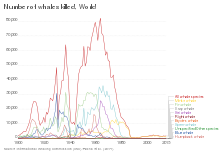

Whaling is the hunting of whales for their usable products such as meat and blubber, which can be turned into a type of oil that was important in the Industrial Revolution. Whaling was practiced as an organized industry as early as 875 AD. By the 16th century, it had become the principal industry in the Basque coastal regions of Spain and France. The whaling industry spread throughout the world and became very profitable in terms of trade and resources. Some regions of the world's oceans, along the animals' migration routes, had a particularly dense whale population and became targets for large concentrations of whaling ships, and the industry continued to grow well into the 20th century. The depletion of some whale species to near extinction led to the banning of whaling in many countries by 1969 and to an international cessation of whaling as an industry in the late 1980s.
Archaeological evidence suggests the earliest known forms of whaling date to at least 3000 BC, practiced by the Inuit and other peoples in the North Atlantic and North Pacific.[1] Coastal communities around the world have long histories of subsistence use of cetaceans, by dolphin drive hunting and by harvesting drift whales. Widespread commercial whaling emerged with organized fleets of whaling ships in the 17th century; competitive national whaling industries in the 18th and 19th centuries; and the introduction of factory ships and explosive harpoons along with the concept of whale harvesting in the first half of the 20th century. By the late 1930s, more than 50,000 whales were killed annually.[2] In 1982, the International Whaling Commission (IWC) decided that there should be a pause on commercial whaling on all whale species from 1986 onwards because of the extreme depletion of most of the whale stocks.[3]
Contemporary whaling for whale meat is subject to intense debate. Iceland, Japan, Norway, First Nations people in Canada, Native Americans in the USA, and the Danish dependencies of the Faroe Islands and Greenland continue to hunt in the 21st century. The IWC ban on commercial whaling has been very successful, with only Iceland, Japan and Norway still engaging in and supporting commercial hunting.[4] They also support having the IWC moratorium lifted on certain whale stocks for hunting.[5] Anti-whaling countries and environmental activists oppose lifting the ban. Under the terms of the IWC moratorium, aboriginal whaling is allowed to continue on a subsistence basis.[6] Over the past few decades, whale watching has become a significant industry in many parts of the world; in some countries it has replaced whaling, but in a few others the two business models exist in an uneasy tension. The live capture of cetaceans for display in aquaria (e.g., captive killer whales) continues.
- ^ "whaling". Britannica Online Encyclopedia. 2001. Retrieved May 16, 2010.
- ^ Francis, Daniel. "Whaling". The Canadian Encyclopedia. Historica Dominion Institute. Retrieved May 16, 2010.
- ^ "Commercial Whaling". iwc.int.
- ^ "Whale Hunting Still Exists in 3 Countries, but It Is Declining". 2023-09-01. Retrieved 2024-10-11.
- ^ ABC News. "Japan, Norway Move to End Whaling Ban". ABC News.
- ^ "Aboriginal substance whaling". About Whales and Dolphins. Retrieved 24 February 2016.